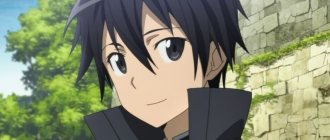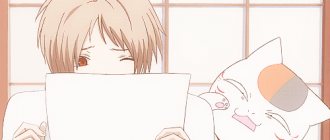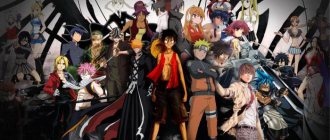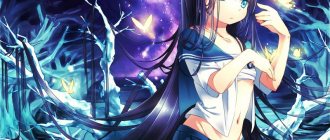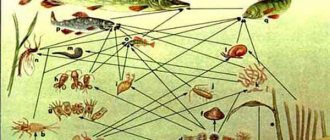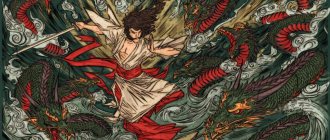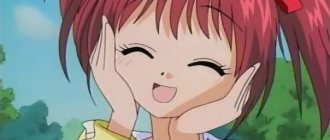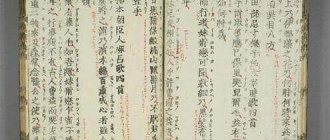What is "anime"?
In Japan itself, the abbreviated term “anime” (アニメ) refers to all animated films (アニメーション) , regardless of the country of origin. Outside Japan, this term refers only to animated films made in Japan, already emphasizing their originality.
What is the difference between anime and animated films from other countries?
The differences are few, but they are significant. Anime is animation designed for a wide audience, not just children. Anyone of any age can find colorful films to suit their taste and needs. Anime has a characteristic expressive depiction of characters and their environment, a characteristic way of conveying movement. Often, anime have a main theme or main song that famous pop and rock artists compete to perform: being in the film means gaining popularity. Lastly, anime are based on manga, a never-ending source of inspiration for Japanese anime artists. Just like manga, anime can continue in endlessly long episodes, which draws in the reader and viewer, eagerly awaiting new releases. Anime facilitates communication between fans of a particular genre who want to express their opinions.
The anime universe and its stylistic features
For a long time, manga remained practically the only source of anime plots, until another great artist came to light, making a real revolution in the world of manga, thereby turning it into a true flagship of Japanese pop culture.
This was Ph.D., animator and consummate mangaka master Osamu Tezuka (1928 – 1989) , often called the Walt Disney of Japanese animation.
He called on anime designers and filmmakers to stop imitating feature-length American cartoons. Tezuka suggested stopping competing with them and focusing entirely on the specific preferences of the domestic audience.
And since in Japan almost everyone reads manga, the best thing that can be given to the viewer of such a wide (in terms of age) audience is television series aimed specifically at the Japanese.
Over time, manga lost its status as the only source of inspiration when creating anime, because it was soon naturally joined by sources such as :
- light novels - fantasy “light novels”, very popular in Japan due to the great variety of genres, the abundance of lively dialogues and the intricacy of plot development lines (how is that?);
- plots (what is this?) of classical literature (most often from historical stories);
- works of Japanese epic;
- “visual novels” based on popular computer games.
Another striking stylistic feature of Japanese animation is the highest quality of voice acting.
In Japan, there is an entire industry for training voice actors, called voice actors .
And if in other countries ordinary actors are invited to perform voice acting, then in the Land of the Rising Sun this is a separate specialty and a highly respected profession. Which is not surprising, since over 60% of all anime series in the world are Japanese-made.
To world glory - through difficulties
The first Japanese anime, as well as the Japanese film industry as a whole, appeared in the early 20th century in the form of films where a picture was drawn with chalk on a blackboard, filmed, then erased to give way to other images and actions. It was a time of silent films, and there were no voiceovers for anime. Initially, they had a commercial or propaganda orientation, aimed at promoting goods or protecting state interests. During the catastrophic earthquake of 1923 in Japan and during the Second World War, many videos of the first anime were irretrievably lost.
The real history of anime begins after World War II, in the 1960s, when film studios were built. One of them is Mushi Production, founded by the famous manga-ga (manga master) Osamu Tezuka, under his leadership and with his participation, released the first anime that became world famous: “Astro Boy” (“Mighty Atom”), “Black Jack” , the first Japanese color animated film, The Jungle Emperor. The Mighty Atom, a fantasy series about the adventures and coming of age of a brave and resourceful robot boy named Atom, was first broadcast on television in 1963 and was an extraordinary success. The genre of the film was defined as shonen anime (movies for boys). The triumphant march of Japanese anime around the world has begun.
Anime - what is this genre and how did it appear?
The origin of the anime universe is closely connected with the emergence of a special type of graphics - manga , the ancestor of which is considered to be the legendary illustrator and engraver Katsushika Hokusai (1760 - 1849).
Being a great master of ukiyo-e, he began to create grotesques (what is that?) and other “strange and/or funny pictures” related to the same plot.
The first series of such pictures, executed exclusively in black and white, appeared in 1814 from the talented hand of Hokusai, who was the first to call works of this kind manga.
But it was only at the beginning of the next century that Japanese filmmakers decided to experiment with “revitalizing” such pictures, picking up the idea of the forerunner of hand-drawn animation, Emile Reynaud, and creating the first two-minute animated film in 1917 .
Oddly enough, the government of Japan made a significant contribution to the development of manga, and in a timely manner managed to discern a very effective tool of influence in this mass hobby.
And it worked perfectly after the end of World War II , when the country was flooded with American occupiers who did not part with their “intellectual ration” - comics .
The Japanese, known for their penchant for minimalism, quickly adapted this format to suit their own audience and gave it more of a national aesthetic, which has long been a tradition in Japanese painting.
And here's what else is typical for this type of graphics :
- schematic representation of mouths and noses;
- obvious depiction of the characters' character - this is done through specific attributes of appearance.
So, for example, a character with a hot temper is endowed with red hair, an eccentric hero or a hooligan is depicted with bleached hair, and some ambiguous or slippery type is depicted with a sullen look and long bangs that almost cover his eyes; - big eyes - in mangas, most characters have huge eyes, which is not at all typical for the Japanese.
However, in the Land of the Rising Sun, wide open eyes are considered not only a symbol of youth and naivety, but also a sign of readiness for contemplation and knowledge of the world; - Literal portrayal of feelings and emotions is one of the key features of Japanese anime.
At any point in the play, any character can be turned into a cute kitten or fluffy bunny, thereby showing that he is in a “goofy mood.” If the hero is angry, his mouth takes on the features of a snarling mouth, and if he is stressed, then he trembles all over and may begin to “discolor.”
Thus, it remains only to clarify that anime is not all animation in general, but Japanese cartoons, which are classified as a special genre of animated films.
Whose interests are anime aimed at?
Numerous genres and subgenres of anime are designed for a wide variety of audiences: in addition to shonen anime, there are films for girls (shojo anime), films for young children and teenagers, for young people and for adults . The theme of the anime combines science and fairy-tale fiction, sports, crime drama, historical legends, parody and comedy. The series of issues with a single, continuous storyline and many characters, with expressive pictures and unexpected turns in the narrative increases the number of fans of all ages who are looking forward to the next episodes.
What anime are considered the most popular?
Anime rating lists depend on the preferences of fans of a particular genre and therefore may differ from each other. For example, we can cite the following anime.
Anime: Spirited Away
Spirited Away is the first foreign animated film in history to win the prestigious Academy Award. The film is about a girl, Chihiro, who finds herself in a ghost world, her parents are turned into pigs, and she has to go through a difficult journey before finding her way back home.
Anime: Princess Mononoke
“Princess Mononoke” is the work of another recognized anime master, Hayao Miyazaki. According to the plot of the film, the young Prince Ashitaka incurs a deadly curse by killing a demonic boar, and goes on a journey to lift the curse. Finding himself in an amazing country where people are at war with the spirits of the forests, he joins their fight, helping the beautiful princess Mononoke.
Anime: "Your Name"
“Your Name,” a romantic story about a girl from the provinces and a boy from Tokyo who are connected by common dreams, received one of the highest ratings in history.
Anime: The Rising of the Shield Hero
The Rising of the Shield Hero has been identified as the most popular film of early 2021. Genre: fantasy; the heroes are ordinary guys who find themselves in another reality and they have to repel the invasion of the Waves of the Apocalypse, who want to destroy all life. The main character, a loser in real life, in another reality receives the right to carry a Sacred Weapon, which can only help in defense and is ineffective in attack. To increase the effectiveness of the weapon, the hero has to overcome many difficulties and improve himself.
Traditional genres
Next we will talk about genres in their typical meaning for a wide audience. Many of them are familiar to you from films and books, but some are typical exclusively for manga and anime.
Harem
— a male character, by coincidence, finds himself surrounded by a large number of girls (according to the canons of the genre, three or more). After which, in the resulting company, the struggle for the attention of the main character begins between the girls. Despite the fact that the genre has a comedic-romantic orientation and a wide variety of character types, building a relationship with any one heroine is not at all necessary. Most often, such a company simply lives in peace and harmony, like one big family.
Nisekoi
Reverse harem
- everything is the same as in a harem, only in reverse - one girl is surrounded by several guys.
Ouran Koukou Host Club
Detective
- a genre that describes the investigation and solution of a mysterious incident. If in cinema and literature this is most often murder, then in anime it can be a search for some trinket or exposing hooligans. The nuances of the narrative will depend greatly on the target audience of a particular work. An essential feature of the detective story is that the actual circumstances of the incident are not revealed to the viewer until the investigation is completed. This allows him to build his own versions at each stage, evaluating known facts.
Monster
In a good detective story, a man holds a severed head in his hand. In bad conditions, blood drips from the head and stains the carpet.
Dobutsu
- an anime about “furry” humanoid creatures. The signs of a dobutsu are “whiskers, paws and tail.” That is, the heroes look like people, but have all the above features. The most popular are “neko” (cat), “kitsune” (fox) and “usagi” (rabbit) representatives.
Spice and Wolf
Drama
- perhaps the most popular genre in art, because it is the one that most strongly touches the strings of the human soul. Such works are characterized by tragedy, deep contradiction of feelings, problems and intractable conflicts. The main aesthetics of drama are the emotional and volitional reactions of a person, expressed in words or actions, and the events that occur often have irreparable consequences.
Hotaru no Haka
Isekai
— an anime about “those who end up” in other worlds. Different time periods, fantasy universes or video game worlds - the setting can be very diverse. The character finds himself in an unusual environment (usually against his will) and uses innate knowledge, skills, or abilities acquired in the new world to achieve his goals.
Re:Zero kara Hajimeru Isek or Seikatsu
Historical
- the actions of the work are related to specific historical events or a specific era. Most often these are episodes from the history of Western Europe, Japan or China. The plot can either correspond to reality or be fictional, but take place in a suitable setting.
Shouwa Genroku Rakugo Shinjuu
Comedy
— we all love to laugh and unwind, but relaxation does not exclude raising serious, sometimes philosophical questions. Despite the fact that comedy is an independent genre, most often we see it as a complement to others (for example, a romantic comedy or action comedy). Comedy itself can be very diverse: from light jokes, ridicule and funny situations to harsh satire.
Danshi Koukousei no Nichijou
Cyberpunk
— about a world in which, against the backdrop of a decline in culture and living standards, there has been a surge in the development of technology. Typically, such works are dark and dystopian, and the atmosphere partially echoes the noir style. The genre is characterized by a spirit of rebellion and protest. The main character, alone or in the company of a group of rebels, opposes the established regime, using knowledge of information technology, hacker skills and body modification.
Ghost in the Shell
High tech, low life
Maho-shoujo
- an offshoot of the shoujo genre, which tells about the adventures of magical girls. Girls usually gain access to magic after transformation (henshin), using certain manipulations with magical objects. They may be accompanied by other sorceresses and magical creatures, and one of the key features of the genre is that the main character needs to hide her supernatural abilities from others. This forces her to lead a double life.
Sailor Moon
Moon Prism, give me strength!
Furs
— an anime about “giant fighting humanoid robots.” The main characters are the characters who control these robots from the inside, and the plot is built on the complexity of contact and synchronization between people and machines, whose task is to save the world. And, of course, it is a widely known fact that the best mech pilots are Japanese schoolchildren.
Neon Genesis Evangelion
Get into the robot, Shinji!
Mystic
- works in this genre are permeated with a spirit of mystery and mystery: strange events, inexplicable phenomena, supernatural forces, otherworldly worlds and chilling creatures that appear out of nowhere. Good mysticism tickles the nerves and fascinates, simultaneously frightening and captivating the viewer. Heroes and characters are either owners of supernatural (psychic) abilities, or representatives of the other world (ghosts, demons).
Mushishi
Parody
— we take one or several well-known works, add a pinch of grotesque, a little humor, do not spare satire, mix it all, bring it to the point of absurdity and the result is an anime in the parody genre.
Gintama
I'm not Zura, I'm Katsura
Everyday life
- a genre that artistically and at the same time most accurately describes the everyday life of ordinary people (most often, schoolchildren). The main goal of such works is to evoke a sense of empathy in the viewer by comparing their own life experiences with the events that happen to the characters in the work.
Byousoku 5 Centimeter
Post-apocalyptic
— life after the “End of the World.” The cause of a global catastrophe could be a war, a virus, an alien invasion, a zombie attack or natural disasters. The events of the work take place a long time after the incident and describe the structure of the world, devoid of its former greatness, with its new laws and orders.
Sakasama no Patema
Apocalyptic
— an anime about the coming of the “End of the World.” Unlike post-apocalyptic fiction, the focus is directly on the disaster itself and the actions of people trying to prevent it.
Highschool of the Dead
Adventures
- An anime about exciting incidents, unexpected events and great achievements. The main character (alone or with comrades) becomes a participant in a certain chain of events that leads him to the path of trials. Using strength, ingenuity and cunning, he overcomes all obstacles and achieves success.
Hunter x Hunter
Psychological
- works with a leisurely pace of narration, where the emphasis is on the thoughts and reasoning of the characters. The main character is usually quick-witted, intelligent, and sometimes eccentric. Both the main protagonist and his opponent can have similar skills, and in this case, the viewer will be treated to an exciting battle of wits, where the winner will be determined by his ability to predict the actions of his opponent.
Death Note
Al, did you know that shinigami only eat apples?
Romance
— about joy and tears, reunions and partings, love and separation. In a word, about everything that is part of human relationships. The main characters are usually schoolchildren or students who overcome love conflicts, mixed feelings and mental anguish, and the main emphasis in the work is on revealing their emotions and experiences.
Kimi no Na wa
Spokon
— about achievements in sports, overcoming difficulties and the desire to win. The center of the story can be either a specific character or an entire team, which, thanks to training, fortitude, high motivation and work, gradually defeats its rivals. The climax of the plot is often the final of some important competition.
Slam Dunk
Oh sport, you are the world!
Steampunk
— the general setting of the works of this genre is that humanity has taken an alternative path of development, directing its efforts to improving engineering mechanics and the technology of steam engines. This made it possible to significantly exceed the level of scientific and technological progress of that time, as a result of which the world became completely different. Attention is focused on the mechanistic nature and environment: complex steam engines, weapons and equipment. Steampunk is characterized by retro aesthetics with a pronounced stylization of the era of Victorian England of the second half of the 19th century, with corresponding cityscapes and contrasting social stratification.
Koutetsujou no Kabaneri
Sentai
— remember the legendary Power Rangers from your distant childhood? This is sentai - a work about the adventures of a permanent team of characters (traditionally of five, less often of three), resisting evil and saving the earth. True, the founder of the genre is not Power Rangers, but the Japanese series Super Sentai, which gave us these people in tights. In the classic setting, the main characters were superheroes, but over time the genre transformed and sentai began to be considered simply a team of “cool guys” whose superpowers were replaced by extraordinary combat skills or the ability to control “giant fighting humanoid robots.”
Power Rangers
Thriller
- works for those who like to tickle their nerves. The viewer is constantly kept in suspense by the twisting twists and turns of the plot and the concealment of the true state of affairs, and emotional involvement occurs due to the enjoyment of the sense of danger.
Steins;Gate
Horror
- scenes of violence, murder, naturalistic display of mutilated organs and blood - everything to evoke feelings of uncertainty, anxiety and fear. Unlike the thriller, this genre is intended not so much to enhance the emotional impact, but simply to scare. Screamers are often used when the viewer flinches from the unexpected appearance of something on the screen accompanied by sharp music.
Higurashi no Naku Koro ni
We create horror stories to help us cope with reality.
Fantastic
- a genre close to fantasy, mysticism and the supernatural, however, unlike them, in fantasy the fictitious is not just fictitious, but fictitious in a plausible way, often based on some scientific facts or hypotheses. It is important to show that the present depicted in the work may be potentially possible in the future under certain conditions.
Toki wo Kakeru Shoujo
The initial ideological and aesthetic setting of science fiction is the dictate of imagination over reality.
Fantasy
- works about worlds ruled not by science and technology, but by “sword and magic.” Elements of Western European folklore are often found, but the flavor of the East or elements of Japanese and Chinese mythologies are often used. The existence of fictional creatures and magical powers is not explained from a scientific point of view, but is an accepted norm of the universe.
Mahoutsukai no Yome
Action
- spectacular works with high narrative dynamics. The plot, despite the strong emotional tension, is usually quite simple and unpretentious, and the main emphasis is on the audio-visual component.
Boku no Hero Academy
Etty
— the target audience is predominantly men, and the main feature is the presence of erotic scenes in the work. Sexual relationships are not shown directly, but there is a large amount of fan service. The characters are shown in ambiguous poses, angles are used that focus attention on the outstanding forms of the heroines, in which the viewer often sees their underwear or bare parts of the body. The canon of the genre is that the main character finds himself in various awkward situations, for example, accidentally appearing in a women's bathhouse or locker room, falling on a girl or colliding with her in the corridor.
- Shoujo-ai
is about love between girls. - Shonen-ai
is about the love of a young man for a young man. ¯\_(ツ)_/¯
High School DxD
Hentai
- an anime that contains sexual scenes. In other words, drawn porn.
- Yuri
- lesbians - Yaoi
- homosexuals
Reader, remember, yuri is your bro, yaoi is not your bro!
Anime phenomenon
Japan, with its island geographical position and its policy of isolation for several centuries, is destined to be a special country, which is manifested in particular in literature and art. Japanese animated films, often based on manga, reflect the unique traditions and customs of the people, which cannot but arouse the interest of any viewer. Anime can be called an international language that, with the help of visual means, makes Japan closer and more understandable to everyone.
Many anime are films with a full-fledged plot line, which touches on issues that concern many: the consequences of the Second World War, relationships between different generations, life difficulties, romantic relationships, environmental problems, morality and ethics. The fantastic world of anime poses questions that humanity will have to solve in the near future.
In addition, the Japanese are very skillful at promoting their products through advertising: images of anime characters or names can be found in the media and on various products. This is greatly facilitated by the “cosplay” movement (a derivative word from “costume play” - costume game), when fans of one or another anime dress up in the clothes of their favorite character, try to resemble him in appearance, but most importantly, try to match him in the soul.
The world of anime is so diverse that it is difficult to fit it under one definition. It’s better to look and form your own opinion. Moreover, you will enjoy it a lot.
What is Anime? What do you eat it with?
It's hard to find a person who has never heard the word "anime" in their life. This popular Japanese art is conquering the world with amazing speed! However, if you still don’t know what your classmates find in these “children’s” cartoons and characters with half-face eyes, it’s time to get to know this trend in more detail.
➣ The term “anime” comes from the English word animation - “animation, animation”. Only English cartoons are not called anime, since this term refers to animation produced specifically in Japan.
Anime is a cartoon invented in Japan. Closely related to this concept is another concept - “manga”. These are comics like the ones you loved to read as a child (and which your mother didn’t want to buy for you because she thought they were stupid).
However, Japanese comics are not only read by children. You will be surprised, but in Japan most of the books are written in the form of comics. Children, teenagers, successful businessmen, and even grandmothers read manga! Only different types of manga are talking about different things. Of course, each type of manga is adapted for people of a certain age.
➣ The word “manga” was invented by the famous artist Katsushika Hokusai in 1814. It means “grotesque, strange or funny pictures.”
If you think that the anime genre is just “big-eyed girls with big eyes,” then you’re wrong! There are a huge number of genres in anime. And we see not only big-eyed girls in Japanese cartoons. There are anime based on traditional Japanese myths, stories, legends and parables. Real anime is a treat for true connoisseurs of Japan. A negative attitude towards this genre may be caused by Americanized cartoons with banal plots. But if you look at it, there is an anime that is useful for everyone to watch!
➣ The first anime appeared in Japan in 1917. Of course, it was very different from what we see now. The very first Japanese animated film is considered to be "New Sketchbook" (Dekoboko Shin Gate, 1917) by Dekoten Shimokawa.
Anime is very different from regular cartoons. Once you watch a Japanese cartoon, you will no longer confuse it with other cartoons.
Anime is characterized by a limited animation method. In other words, the number of frames in the anime is not so large, while the background and characters are detailed. Initially, this technique was used because anime projects were poorly funded, and animators saved as much as they could.
➣ The first successful anime series in Japan was “The Mighty Atom” (Tetsuwan Atom, 1963). It was black and white. But the very first was “Calendar in Pictures from the Otogi Studio” (1962).
Of course, the most classic sign of anime is big eyes. They look disproportionate on the face, but despite this, you can't help but like Japanese cartoon characters!
Do you know why the Japanese, people with narrow eyes, have big-eyed heroes? This is due to several reasons. Large glowing eyes with long eyelashes were originally only depicted in shoujo manga characters. In the East it is considered very beautiful. In addition, from the Japanese point of view, the eyes are the central object on the face (whereas in American animation the mouth is such an object). They convey the emotionality of the character, his age and even character traits!
That’s why young, naive, open-minded heroes are portrayed as big-eyed. But evil characters, on the contrary, have narrow eyes.
➣ By the way, another feature of the anime. Heroes can easily turn into a plush cat (dog, bunny) with attributes such as a tail and ears. This is how the creators emphasize the character’s frivolity and naivety.
Here are some other interesting features of the characters' faces. You already understand that the Japanese love to express emotions. The facial expression of one character can change a hundred times per minute! What do these changes mean?
If the corner of a character’s mouth “drips” down, it means he is grinning nervously or is worried. If the hero suddenly “bleaches” and strange stripes begin to squirm in the background, it means he is in a state of stress.
When a bead of sweat appears on the face, the character is thinking about what he cannot do, or is afraid.
When you watch a couple of TV series, such facial expressions and gestures will become clear to you.
The term “cosplay” is common in the anime community. This word is an abbreviation of the English costumed play, which translates as “costume game”. In a way, it's like a carnival. Anime fans organize a variety of festivals where they appear as their favorite characters. To do this, they recreate the costumes and paraphernalia of the heroes of their favorite genre from scrap materials. There are even professional cosplayers - their costumes cannot be distinguished from the original!
Of course, in Russia cosplay is not yet as popular as in its homeland, Japan. There are even special stores where you can buy ready-made paraphernalia.
A less expensive pleasure is fan fiction. This word comes from the English fan fiction - “creativity of fans.”
True, they require almost more time and skill than cosplay. Fan fiction is a story about the adventures of your favorite anime characters. And not only anime, but also films and books. Some fan fiction creators come up with their own characters that exist in an already made-up world. Sometimes such stories turn out to be almost more interesting than the original!
There is a huge variety of anime genres. We will talk about some of them below.
Anime genres
Shounen
This is the so-called anime for boys. It is designed for young people from 12 to 18 years old. This genre finally took shape by 1964. Its plot can be described quite simply: a story about a boy who saves the world. Does it seem boring and uninteresting to you? Well, that’s why this is an anime for boys - they always want to save someone...
Shoujo
As you may have guessed, if there is anime for boys, then why not anime for girls!
Shoujo anime is aimed at girls your age. This genre of anime reflects what interests you: relationships with guys, romantic relationships between characters, first love...
With all this, characters can have magical abilities - this is welcome in shoujo anime! For example, the well-known series “Sailor Moon” tells about a girl who receives a magical artifact with which she can perform good deeds in the name of the Moon. In other anime, the main character is a hereditary sorceress or has magical powers.
Spokon
Anime of this genre tells about the adventures of young athletes, their friends and opponents. And the name of the genre consists of two words: “sport” and “willpower”.
Kodomo
When you were little, you probably saw such anime created specifically for children. These are "Maya the Bee", "Lulu the Angel of Flowers", "Grendizer" and "Speedy Racer".
Seinen is an anime for adult men (from 18 to 25-40 years old). Characteristic features of this genre are elements of psychology, satire, eroticism, and more attention is paid to character development.[5] Seinen is sometimes confused with shoujo, but works in this genre are more realistic and darker (Maison Ikkoku, Ghost in the Shell), and the plot is not tied to a romantic story, although a love story may be present (Monster, Berserk). In rare cases, seinen anime or manga are aimed at businessmen over the age of 35-40.
Josei is an anime or manga for women.[6] The plot most often describes the daily life of a woman living in Japan. As a rule, part of the story is devoted to events from the school life of the main character (it is at this time that she meets other characters and the plot begins). The drawing style used in josei is a little more realistic than in shojo, but retains some of its characteristic features. Again, unlike shojo, love relationships are depicted in josei in a much more elaborate way (Paradise Kiss, Honey and Clover).
Seinen is an anime for adult men (from 18 to 25-40 years old). The characteristic features of this genre are elements of psychology, satire, eroticism, and more attention is paid to character development. Seinen is sometimes confused with shoujo, but works in this genre are more realistic and darker (Maison Ikkoku, Ghost in the Shell), and the plot is not tied to a romantic story, although a love story may be present (Monster, Berserk). In rare cases, seinen anime or manga are aimed at businessmen over the age of 35-40.
Josei is an anime or manga for women. The plot most often describes the daily life of a woman living in Japan. As a rule, part of the story is devoted to events from the school life of the main character (it is at this time that she meets other characters and the plot begins). The drawing style used in josei is a little more realistic than in shojo, but retains some of its characteristic features. Again, unlike shojo, love relationships are depicted in josei in a much more elaborate way (Paradise Kiss, Honey and Clover).
Dobutsu
Dobutsu is translated from Japanese as “fluffy”. Japanese animators love to talk about the adventures of humanoid “furry” creatures. His heroes look like people, but at the same time have mustaches, paws and a tail.
In addition, anime includes genres such as fantasy, cyberpunk, mystery, drama, and many others. If you are interested in this Japanese art, you can easily find anime in stores or online. Usually it is recommended to start getting acquainted with anime with the classics of the genre. Surely you will like the anime films of Hayao Miyazaki (“Princess Mononoke”, “My Neighbor Totoro”, “Kiki’s Delivery Service”, “Spirited Away”, etc.). In Kazakhstan, Anime is developing slowly but surely. Many people became interested in anime and watched it.
I believe that knowing Japanese is not necessary in order to become a pure fan of anime or, more precisely, an otaku, the most important thing is that you like it and evoke certain feelings, and the Japanese language is for those who are interested in studying and learning something new, I can say the same about the qualities that an anime fan should have.
@https://shiki27.yvision.kz/profile/
